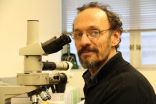Timing of test, surgery, insurance examined in sleep-disordered-breathing cases
2014-12-11
(Press-News.org) Children with public insurance waited longer after initial evaluation for sleep-disordered breathing (SDB) to undergo polysomnography (PSG, the gold standard diagnostic test) and also waited longer after PSG to have surgery to treat the condition with adenotonsillectomy (AT) compared with children who were privately insured, according to a report published online by JAMA Otolaryngology-Head & Neck Surgery.
Low socioeconomic status (SES) is a barrier to quality care and improved health outcomes. SDB is a spectrum of sleep disruption that ranges from snoring to obstructive sleep apnea (OSA). Low SES is a risk factor for SDB. PSG is an overnight sleep test and is the standard for diagnosing OSA, according to the study background.
Emily F. Boss, M.D., M.P.H., of the Johns Hopkins School of Medicine, Baltimore, and co-authors examined the timing of PSG in relation to ultimate surgical therapy with AT and the differences based on SES as measured by receipt of public insurance. The study looked at patients newly evaluated for SDB over a three-month period in outpatient pediatric otolaryngology clinics who did not have a prior PSG ordered and had a minimum of one year of follow-up.
A total of 136 children (without PSG) were evaluated and 62 children (45.6 percent) had public insurance. Polysomnography was recommended for 55 children (27 of 55 [49 percent] with public insurance vs. 28 of 55 [50 percent] with private insurance), according to the study results. After the initial visit, 24 of 55 children with PSG requested (44 percent) were lost to follow-up regardless of insurance status.
Results show children with public insurance who obtained PSG waited longer between the initial encounter and PSG (average interval, 141.1 days ) than children who were privately insured (average interval, 49.9 days). For children who ultimately had surgery after getting a PSG (n=14), the average time to AT was longer for children with public insurance (222.3 days vs. 95.2 days).
"To our knowledge, this is the first study to evaluate differences in timing by insurance status of PSG and surgery for children with SDB. Findings from this study, while profound, should be further validated with patient-level prospective research prior to formal changes in practice or policy," the authors note.
INFORMATION:
(JAMA Otolaryngol Head Neck Surg. Published online December 11, 2014. doi:10.1001/.jamaoto.2014.3085. Available pre-embargo to the media at http://media.jamanetwork.com.)
Editor's Note: An author more a funding/support disclosure. Please see article for additional information, including other authors, author contributions and affiliations, financial disclosures, funding and support, etc.
Media Advisory: To contact author Emily F. Boss, M.D., Ph.D., call Ekaterina Pesheva at 410-502-9433 or email epeshev1@jhmi.edu.
ELSE PRESS RELEASES FROM THIS DATE:
2014-12-11
EAST LANSING, Mich. - It's well known that chemotherapy helps fight cancer. It's also known that it wreaks havoc on normal, healthy cells.
Michigan State University scientists are closer to discovering a possible way to boost healthy cell production in cancer patients as they receive chemotherapy. By adding thymine - a natural building block found in DNA - into normal cells, they found it stimulated gene production and caused them to multiply.
The study can be found online in the journal Molecular Cell.
"In most cases, cancer patients who receive chemotherapy lose ...
2014-12-11
MADISON, Wis. -- Frederick Crane was a researcher under David E. Green in the mid-1950s, during the early days of the University of Wisconsin-Madison Enzyme Institute, when he made his defining discovery.
The lab group was on a mission to determine, bit by bit, how mitochondria -- the power plants of cells -- generate the energy required to sustain life. What Crane found, a compound called coenzyme Q, was a missing piece of the puzzle and became a major part of the legacy of mitochondrial research at UW-Madison. But it was no accident.
"It was the result of a long ...
2014-12-11
Montréal, December 11, 2014 - Researchers in Montréal led by Jacques Drouin, D.Sc., uncovered a mechanism regulating dopamine levels in the brain by working on a mouse model of late onset Parkinson's disease. The study, conducted in collaboration with Dr. Rory A. Fisher from the Department of Pharmacology at the University of Iowa Carver College of Medicine, is published online today by the scientific journal PLoS Genetics.
Using gene expression profiling, a method to measure the activity of thousands of genes, researchers investigated dopaminergic neurons in ...
2014-12-11
WEST LAFAYETTE, Ind. - A new method that creates large-area patterns of three-dimensional nanoshapes from metal sheets represents a potential manufacturing system to inexpensively mass produce innovations such as "plasmonic metamaterials" for advanced technologies.
The metamaterials have engineered surfaces that contain features, patterns or elements on the scale of nanometers that enable unprecedented control of light and could bring innovations such as high-speed electronics, advanced sensors and solar cells.
The new method, called laser shock imprinting, creates shapes ...
2014-12-11
A new study led by researchers at University of California, San Diego School of Medicine finds that the brains of obese children literally light up differently when tasting sugar.
Published online in International Journal of Obesity, the study does not show a causal relationship between sugar hypersensitivity and overeating but it does support the idea that the growing number of America's obese youth may have a heightened psychological reward response to food.
This elevated sense of "food reward" - which involves being motivated by food and deriving a good feeling ...
2014-12-11
PORTLAND, Ore. -- A large international group of scientists, including an Oregon Health & Science University neuroscientist, is publishing this week the results of a first-ever look at the genome of dozens of common birds. The scientists' research tells the story of how modern birds evolved after the mass extinction that wiped out dinosaurs and almost everything else on Earth 66 million years ago, and gives new details on how birds came to have feathers, flight and song.
The consortium of more than 200 scientists is publishing its findings nearly simultaneously this week ...
2014-12-11
A team of researchers led by North Carolina State University has found that stacking materials that are only one atom thick can create semiconductor junctions that transfer charge efficiently, regardless of whether the crystalline structure of the materials is mismatched - lowering the manufacturing cost for a wide variety of semiconductor devices such as solar cells, lasers and LEDs.
"This work demonstrates that by stacking multiple two-dimensional (2-D) materials in random ways we can create semiconductor junctions that are as functional as those with perfect alignment" ...
2014-12-11
Agricultural decisions made by our ancestors more than 10,000 years ago could hold the key to food security in the future, according to new research by the University of Sheffield.
Scientists, looking at why the first arable farmers chose to domesticate some cereal crops and not others, studied those that originated in the Fertile Crescent, an arc of land in western Asia from the Mediterranean Sea to the Persian Gulf.
They grew wild versions of what are now staple foods like wheat and barley along with other grasses from the region to identify the traits that make some ...
2014-12-11
GAINESVILLE, Fla. --- Nature abhors a vacuum, which may explain the findings of a new study showing that bird evolution exploded 65 million years ago when nearly everything else on earth -- dinosaurs included -- died out.
The study is part of an ambitious project, published in today's issue of the journal Science, in which hundreds of scientists worldwide have decoded the avian genome.
Edward Braun, an evolutionary geneticist at the University of Florida and the UF Genetics Institute, is one of the key scientists who took part in this multi-year project that used nine ...
2014-12-11
(Santa Barbara, Calif.) -- With more and more rainforest giving way to pasture and grazing land every year, the practice of cattle ranching in the Amazon has serious implications on a global scale. At the same time, however, it provides a degree of socioeconomic flexibility for Amazonian smallholders who simply can't survive on what the forest or agriculture provide.
In a paper published in the current issue of the journal Human Organization, UC Santa Barbara anthropologist Jeffrey Hoelle takes a look at the rise of cattle ranching in the Brazilian state of Acre and the ...
LAST 30 PRESS RELEASES:
[Press-News.org] Timing of test, surgery, insurance examined in sleep-disordered-breathing cases

